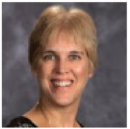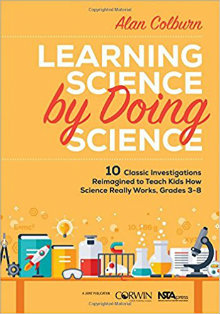Teaching Kids How Science Really Works
Learning Science by Doing Science: 10 Classic Investigations Reimagined to Teach Kids How Science Really Works, Grades 3-8
By Alan Colburn
(Corwin / NSTA Press, 2017 – Learn more)
 Reviewed by Joyce Depenbusch
Reviewed by Joyce Depenbusch
The title of this book caught my attention since I am a believer in doing science to learn it. The author, Alan Colburn, is a professor of science education at California State University Long Beach. He skillfully takes the idea of learning through doing to make a very useful resource for teachers.
I especially liked the way he weaves in the use of the Next Generation Science Standards (NGSS) in an understandable way and provides directions for 3-8th grade level activities that are easy to follow and do.
 In fact, I was so impressed with the way the author connects the old “tried and true” lessons with this newer way of thinking that I suggested this book as part of a professional development that is being planned for next summer. A similar professional development was done this year, but the book study was not as satisfactory to science teachers as I think this one will be.
In fact, I was so impressed with the way the author connects the old “tried and true” lessons with this newer way of thinking that I suggested this book as part of a professional development that is being planned for next summer. A similar professional development was done this year, but the book study was not as satisfactory to science teachers as I think this one will be.
I believe teachers will find the book helpful and their students will also be engaged in the lessons Colburn presents. Busy teachers will appreciate the fairly readily available equipment required, the clear instructions, and explanations.
What you will find in each chapter
Each chapter is organized in a similar way. Step-by-step directions are provided for a classroom activity in the Try It! section. This section also includes a materials list, a description of what aspects of the 5E model of instruction are used, and a discussion of connections to NGSS.
Suggestions, tips and supporting ideas are noted on the Teaching Tips section. For example, on page 22, teachers are given suggestions on the way to respond to students so that they continue to pursue deeper learning.
What’s Going On in the Science? provides background information that is clearly written and should be helpful to readers. Misconceptions are addressed so that if students and teachers are unclear, the ideas are further explained. Page 42, for example, spells out the differences between a theory and a law in science. These terms vary from the way they are used outside of science and have been too frequently misunderstood.
In the Practices in Practice section, Science and Engineering Practices (SEPs) are contrasted for 3rd-5th and 6th-8th grades so the transitions of each grade levels’ expectations are provided. (There is an easy-to-read chart provided in the NGSS that shows these transitions between grade levels.)
Connecting to the Nature of Science takes the essential aspects of the nature of science and links them to the activity. For example, on page 140, the author skillfully connects science and engineering in a way that spells out the need for retesting and the opportunity for multiple solutions.
I especially enjoyed the Case in Point studies where real scientists’ struggles in science were shared. Appendix A provides the background into NGSS if readers are not familiar with the specifics of the standards.
Appendix B may be the most valuable section of the book especially for novice science teachers since it is an interview with several experienced elementary and middle school science teachers. They provide some advice and suggestions that you should not miss.
Throughout the book connections are made to A Framework for K-12 Science Education, which provides the foundation for the Next Generation Science Standards. The Framework is essential to the changes being encouraged in NGSS. If teachers want an explanation of what they are being asked to do, the answers can be found there.
This is a minor factor, but I like the coating on the cover. It should add to durability and possibly help repel moisture. Too often as a science teacher (and a cook), I find the books I use the most show wear.
There is no such thing as a content-free lesson.
One sentence that should be uppermost in the minds of teachers is found on page 113. “There is no such thing as a content-free lesson.” This is mentioned with a seed germination exploration that the author shares three times, with a different approach being used each time.
The modifications of the same lesson show teachers the changes that can easily be made to achieve the goals of the NGSS. That sentence is important because too often popular STEM activities can be done randomly for a fun day and not tied to educational goals.
Most everything old can be new again.
One of the things that caught my attention as I read was the first activity in the book, “Milk Fireworks.” I have done this lesson from time to time for many years, long before NGSS was even suggested. Kids like it and even adult participants at a workshop I did just this summer oohed and aahed at the results they got to experience first hand. The fact that this same activity shows up as the first one in this book made me glad that I have continued to use it and reinforces the idea that teaching with the NGSS does not require all old activities be tossed out. It does require a revamping of how the lesson is taught.
So, don’t throw the “baby out with the bath water” in the process of changing to teach the new science standards. As the subtitle of this book suggests, classic investigations are reimagined to teach kids how science really works.
The goal is that all students be taught rigorous science content including all standards, not just the ones we make time for. Students are required to do more of the thinking, questioning and processing of the information.
Colburn’s book assists science teachers, young and old, in the process of making this important change. Read this book. I think you will gain a deeper knowledge of the how and the why of teaching science with the NGSS.
For more than 39 years Joyce Depenbusch has been involved in education in one way or another. In elementary and middle school classrooms and as the wildlife education coordinator for Kansas, she has combined her love of children and nature. Currently, she is a middle school science teacher in rural south-central Kansas. Joyce enjoys presenting at workshops about ways to implement the NGSS and spending time on the family farm.

































